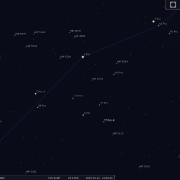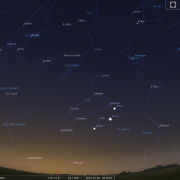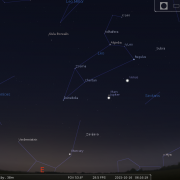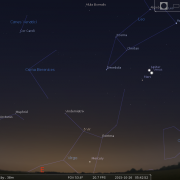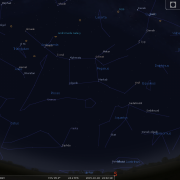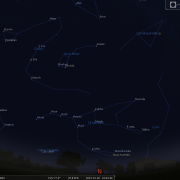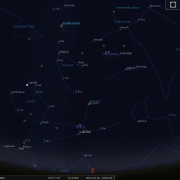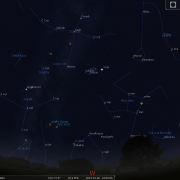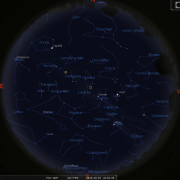In this month's Sky Notes:
Planetary Skylights
 Saturn continues to linger in evening twilight sky very low the SW, but by mid month it is just about lost in glare.
Saturn continues to linger in evening twilight sky very low the SW, but by mid month it is just about lost in glare.

 Uranus and Neptune as the only 'evening planets' visible, but a telescope is required to reveal their tiny disks. Uranus comes to opposition on the 12th residing in Pisces below eta Piscis (see chart) and will be due south at midnight. Neptune resides in Aquarius between the two naked eye stars of sigma and lambda Aquarii.
Uranus and Neptune as the only 'evening planets' visible, but a telescope is required to reveal their tiny disks. Uranus comes to opposition on the 12th residing in Pisces below eta Piscis (see chart) and will be due south at midnight. Neptune resides in Aquarius between the two naked eye stars of sigma and lambda Aquarii.



 All the planetary action is to be found in the early morning sky, where Venus, Mars, Jupiter and Mercury all reside. View to the east at 06:00h between the 8-11th when the waning crescent moon slides by all the planets. Brilliant Venus is uppermost, then Mars, followed by conspicuous Jupiter and finally, just above the horizon, Mercury. Mars and Jupiter are closest on the 17 & 18th with Jupiter and Venus closest on the 26th, Finally, Mars and Venus are closest on the 31st!
All the planetary action is to be found in the early morning sky, where Venus, Mars, Jupiter and Mercury all reside. View to the east at 06:00h between the 8-11th when the waning crescent moon slides by all the planets. Brilliant Venus is uppermost, then Mars, followed by conspicuous Jupiter and finally, just above the horizon, Mercury. Mars and Jupiter are closest on the 17 & 18th with Jupiter and Venus closest on the 26th, Finally, Mars and Venus are closest on the 31st!
 Mercury has its best morning apparition of the year growing in brightness as October progresses, although it will be slipping back toward the horizon at the same time. The optimum window to observe Mercury will be around mid month when it is at its highest above the horizon, at 10 degrees. Look due East around 06:00h.
Mercury has its best morning apparition of the year growing in brightness as October progresses, although it will be slipping back toward the horizon at the same time. The optimum window to observe Mercury will be around mid month when it is at its highest above the horizon, at 10 degrees. Look due East around 06:00h.
Meteor Activity

The Orionids (Oct 16-27) are the month's most reliable shower, peaking during daylight hours on the 21st, therefore unusually the hours before midnight on the 21st will be best. Hourly rates are in the mid twenties, however actual observed rates will be around 8-10 per hour. Like May’s Eta Aquarids, Orionids are associated with Comet Halley; Orionids are swift, often producing persistent trains. With the moon around quarter phase, prospects look reasonable.
The weak Piscid shower has three peak dates, Oct 13th being the optimum. Observed rates are little better than sporadic levels - around 3-7 per hour. Piscid meteors are often slow, of long duration, but not very brilliant. Perhaps the most interesting shower is the Giacobinids or Draconids (Oct 6-10th peaking on the 9th) which are associated with the periodic comet Giacabini- Zinner (6yrs) The shower is very erratic, but can produce outbursts of activity so keep an eye open. Early morning viewing will be the optimum time
|
Looking South
Mid October - 22:00h |
Looking North |
|
Looking East
Mid October - 22:00h |
Looking West
Mid October - 22:00h |
|
|
|
|
Overview
Mid October - 22:00h |
|
Additional Image Credits:
- Planets and Comets where not otherwise mentioned: NASA
- Sky Charts: Stellarium Software
- Log in to post comments

